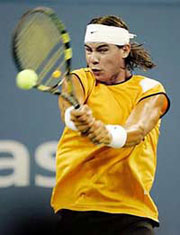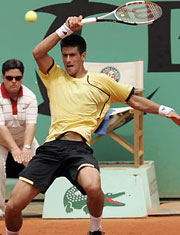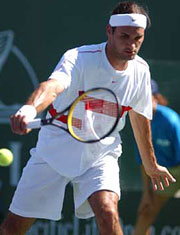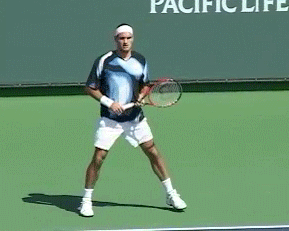|
TennisOne Lessons Grass Court Tactics For All-Court Players Philippe Azar
For many years, players have been requesting a longer gap between the end of Roland Garros – played on clay, the slowest surface in tennis - and the start of Wimbledon – played on grass, the fastest surface - to allow more time to adapt their games to the different surfaces. However, given the results from the last couple of years, it seems that they are managing this transition very well: Three of this years Wimbledon’s semi-finalists (Nadal, Djokovic, Federer) were also semi-finalists at this year’s Roland Garros and Richard Gasquet - the fourth Wimbledon semi-finalist - generally rates clay as his favourite surface. Moreover, going a round or two further back in this year’s Wimbledon draw, names like Juan Carlos Ferrero, Nikolay Davydenko, Marcos Baghdatis appear – all players who generally prefer slower, firmer grounds.
Looking at the present rankings, they are dominated by players who are just as likely to inflict competitive pain on the fastest of surfaces as they are to torture their opponents on the slowest courts. So it seems that we are entering a new tennis era, one where court surface specialists are slowly disappearing. This year’s grasscourt season showed how the top players are willing to adapt their styles to suit the surface and ambient conditions. It’s nice to see them embrace the challenges that the fastest surface in the tennis calendar poses rather than lamely blame and fall victim to it. There’s no doubting that the recent successes of many clay-courters at Wimbledon are in part due to the surface having become a tad slower by letting the grass grow just a little longer. But let’s not diminish the efforts that they have made and the inherent belief of success that comes with that effort. Let’s have a look at the two main adaptations apparent at Wimbledon this year: Slice Would Be Nice Probably the single most important alteration that successful players make during the grass court season is their increased use of backspin. Federer is by far the most successful exponent of this and has long recognised that it can be a very effective way of not only retrieving difficult balls but also putting pressure on an opponent.
Not to be outdone, a number of players have joined into the fun - players who otherwise seem to take pride in not chipping their way through a match. There is still a misguided perception amongst top professionals that backspin is synonymous with defence and to be avoided. And yet, at this year’s Wimbledon, we even saw Rafael Nadal using it regularly, a player who otherwise next-to-never resorts to backspin. A crisp backspin ball on grass will stay lower than on any other surface, low enough to pose all kinds of mayhem for players using extreme topspin grips. Furthermore, because a ball hit with backspin typically travels slower and bounces differently to the staple topspin, it is effective in changing the pace of the ball and thereby disturbing the opponent’s rhythm. Countless times at this year’s Wimbledon an unforced error followed a nice, deep, slow crosscourt backspinhit into an opponent’s backhand. And Federer has the rare ability to use this shot to draw opponents to the net - a place where they are least comfortable and wouldn’t necessarily venture on their on. By targeting his backspins low and crosscourt to the side-T, we saw him regularly force opponents forward and outward only to see their weak high-bouncing retrieves converted into easy Federer passing shots. Volleys Serve-and-volleyers used to rule the tennis roost many decades ago when most tournaments were played on grass and competitors would come up to net more often than not. They no longer do so. Hard cement surfaces have slowed the ball down and made it bounce higher, players have improved their baseline play and, as a result, their returns. Furthermore, racquet technology allows returns to be hit nearly as hard as serves making the volley often unreachable or difficult to control.
Today, the rankings are dominated by baseline-huggers who construct their game plans around booming groundstroke winners from the back of the court while minimising unforced errors. But, under the tutelage of Federer, who has had a fair amount of success at the net over the last few years and Andy Roddick who recently seems far more willing to venture forward under the mentorship of his coach Jimmy Connors, it seems that many more players this year are inclined to venture away from home-sweet-home. No one was more impressive at this than Rafael Nadal. Given his reluctance to come forward in recent years, the latent observer may have been forgiven for believing that Nadal simply did not know how to volley. But, over the last couple of seasons he has been entering doubles competitions in many of the smaller events. This has clearly had an impact his volleying skills and his ability to use them in a competitive environment. The effort paid off at this year’s Wimbledon where he came to the net far more regularly (more than twice as often as he did in his French Open final four weeks earlier) and won, onan average, 70% of his net approaches, a very respectable score. Novak Djokovic - the new super-rookie who came into Wimbledon ranked four in the world on the back of some very good baseline-based results - hired the services of Mark Woodforde, the legendary doubles specialist, to be his “volleying consultant” for the duration of the tournament. While it is not unheard off for players to hire the services of specialist coaches over longer time spans to improve specific areas of their game, it is very rare for a player to hire someone just for the duration of a tournament. The help they can provide in such a short time is at best debatable, at worst too-little-too-late. Nevertheless, ‘intention before result’ and Djokovic’s move was a sign that he rocognized that volleying had to be an important component of his game plan during Wimbledon if he was going to survive deep into the draw.
Regardless of the surface, coming up to the net from time to time is a smart tactic. Knowing that an opponent is not averse to running to the net poses all kinds of challenges and forces a player to keep balls consistently deep, aggressive, and purposeful. Anything less is likely to be punished by net-attack. Strategically, it was good to see the men’s semi-finalists were all players who usually have most of their success from the baseline were willing to adapt their styles to suit the intricacies of grass-court play. Nadal was perhaps the most impressive in this transition. Here is a player whose baseline play has brought him countless tournament victories including three consecutive French Opens. But despite those successes, by the time Wimbledon came round, he was willing to get out of his comfort zone by coming up to the net out of free-will, using backspin constructively rather than defensively, and to try shot combinations which he might otherwise never choose.
And Rafa did all of this on the world’s biggest tennis stage. There was much to be lost but also much to be gained. The risks paid off and he showed a whole new facet to his growing repertoire of shots. Yet even as recently as a couple of seasons ago, he had an A-plan only which rested on grinding his opponent from the baseline. it is clear that he has made a commitment to bringing his game to the next level by developing a B and C plan in case A isn’t working. Through this, he is bound to become a far more versatile and dangerous player in the future. We, mere mortal players and weekend hackers, can learn much from this. It takes courage to alter a formula that has brought success; but certain situations and opponents make it necessary. The alterations need not be reckless or radical and can be as simple as what has been described here. Very often small changes can bring about big results! Your comments are welcome. Let us know what you think about Philippe Azar's article by emailing us here at TennisOne.
Philippe Azar is a professional with Peter Burwash International (PBI) and has been teaching tennis internationally for more than 15 years. He is presently based at Tokyo Lawn Tennis Club in Japan. PBI contracts with resorts, hotels and clubs all over the world to direct tennis programs.The company presently has professionals working at 62 facilities in North America, Europe, Asia, Middle East, Caribbean, Pacific and Indian Ocean. During its 30 years in business, PBI tennis professionals have taught tennis to over three million students in more than 135 countries. For more information visit: pbitennis.com |



